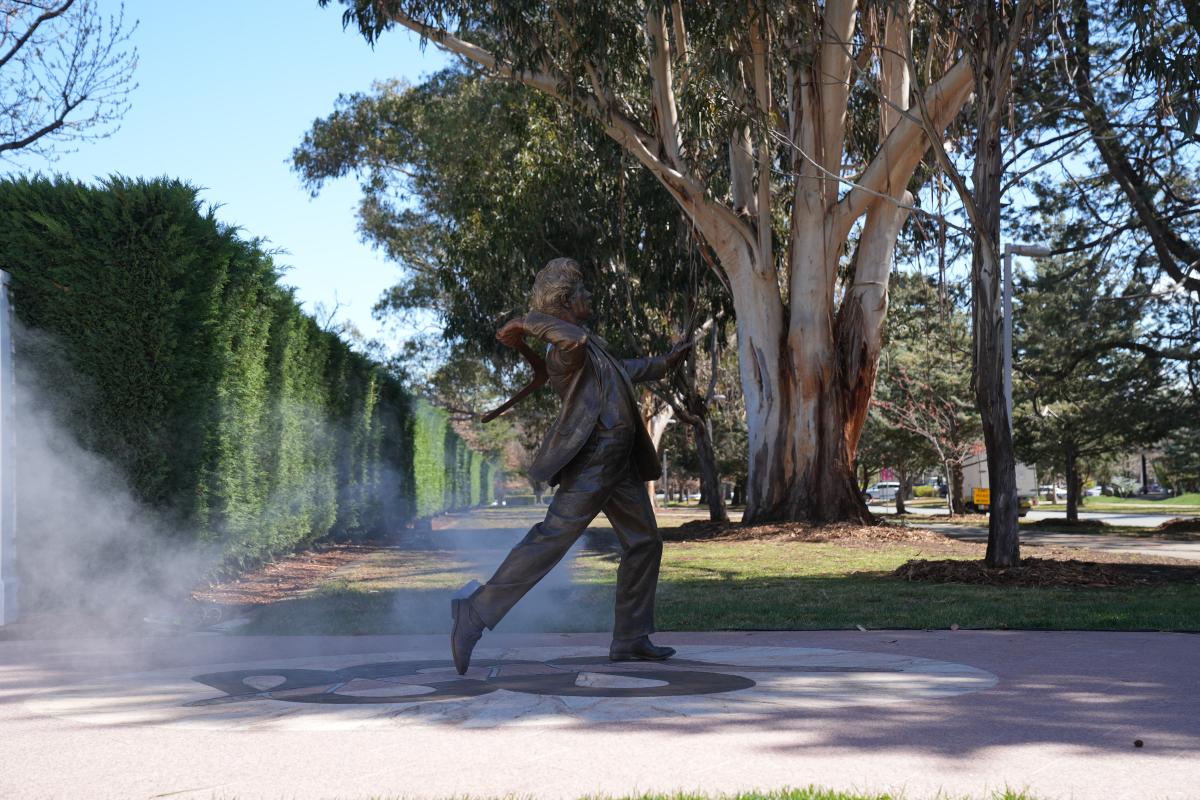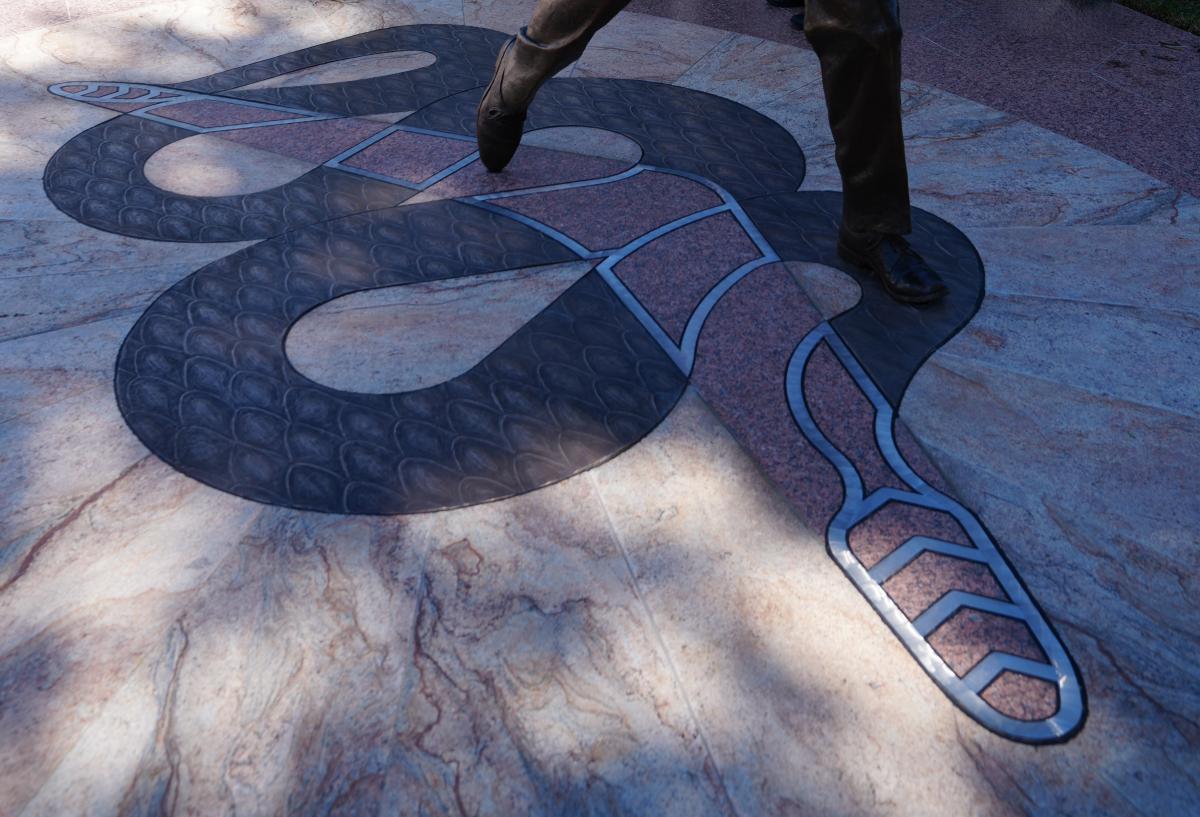Senator Neville Bonner AO Commemoration
- Home
- Attractions
- Senator Neville Bonner AO Commemoration
On 17 September 2025, the 54th Anniversary of his boomerang demonstration in the Old Parliament House Senate Rose Gardens, Senator the Hon Katy Gallagher and members of Neville Bonner’s family unveiled a sculpture of Senator Neville Bonner AO (1922-1999).
Neville Bonner AO, a Jagera man, was the first Aboriginal person elected to any Australian Parliament, as the Senator for Queensland. Following the 1967 referendum he joined the Liberal Party. He spent 12 years in Parliament (1971-1983), initially to fill a casual Senate vacancy for the Liberal Party and went on to be elected 4 more times.
This permanent tribute celebrates Bonner’s legacy and contribution to Australian political history as a champion for the rights of Aboriginal Australians to retain cultural identity while accessing education, economic opportunity and social inclusion.
The full body sculpture by Louis Laumen is located near the north-west corner of Old Parliament House. Neville Bonner’s depiction is based on his 1971 boomerang throwing demonstration nearby, in the Senate Old Parliament House Rose Gardens. Bonner stands with his totem, Kabul the carpet snake, overlaid with a boomerang design by Barkindji artist, David Doyle.
Some key features about the artwork include:
- red granite in the pavement pays tribute to the location as the Senate side
- the paver layout mimics snake scales, complementing the totem artwork
- the boomerang shape in the pavement artwork was informed by one of Bonner’s originals – held at the Museum of Australian Democracy.
Neville Bonner bio - as shared by family
Neville Thomas Bonner AO (1922-1999), a Jagera man, was the first Aboriginal person elected to any Australian Parliament, as Senator for Queensland.
Bonner was born on Ukerebagh Island, Tweed Heads, NSW, Bundjalung Country. In his formative years, racism restricted Bonner’s access to formal education. His grandmother ensured his Aboriginal heritage took pride of place and knew the importance of nurturing his reading and writing skills. Bonner was determined to learn and worked in many industries across rural Qld and NSW.
In 1945, he followed his future wife to Palm Island, an Aboriginal reserve in Queensland where together they raised his children. He became a foundation member of the Palm Island Social and Welfare Association.
In 1960, Bonner moved his family to Ipswich, Queensland, Jagera Country, where he opened Bonnerang, a store dedicated to manufacturing Boomerangs. A growing interest in politics led to his association with the One People of Australia League (OPAL), An Aboriginal rights organisation, where he became its Queensland president.
Following the 1967 referendum, Bonner entered politics and joined the Liberal Party. In 1971 Bonner was appointed to the federal Senate and then elected in the elections of 1972, 1974, 1975 and 1980. A proven and highly respected politician by the community and across all spheres of politics. He displayed statesman level qualities few politicians have matched since.
Bonner’s family, community and political life involved meeting a difficult balance of expectations between Indigenous and non-Indigenous way. A role he achieved with great dignity and unquestionable ethics.
In 1979, Bonner was named Australian of the Year for his significant contribution to Indigenous rights.
Today, Neville Bonner’s legacy lives on through his family and with Australians who share his passion for Aboriginal advancement and for his dedication to serving the broader community.
For further educational resources associated with Neville Bonner please refer to the Museum of Australian Democracy education page.

Words from David Doyle – Pavement Artwork Artist
Neville, it has been one of the great honours of my life to contribute to this place that now holds your memory.
When I was asked to design the base for your statue, I knew it had to carry more than decoration. It had to speak to who you were, to the Country you came from, and to the legacy you left behind.
The carpet snake rests here in bronze, honouring your totem — a symbol of strength, of culture, of connection. And running through its very body is the red granite boomerang. Not beside it, not apart from it, but joined within it. Because your totem and your boomerang, your spirit and your story, are inseparable. The boomerang speaks both to your political journey and to the design you carved with your own hands. It is you, woven into your totem, standing as one.
The chevrons set into the snake come directly from that very boomerang. They are your hand, your mark, carried forward into stone and metal. And every scale on this snake flows in the same direction, because you believed that Australia, no matter its differences, must move forward together as one.
In our culture, the U-shape represents a person. Every scale here is made from that shape. Each one is a person — the people you stood for, the people you spoke to, the people who walked beside you. Each scale reminds us that true leadership is not about standing alone, but about carrying others forward.
Neville, this work is my way of saying thank you. Thank you for the dignity you carried. Thank you for the truth you spoke. Thank you for showing that even in the hardest of places, there is always room for courage, for vision, and for unity.
I hope that when people stand here, they don’t just see stone and bronze. I hope they feel your story beneath their feet. I hope they remember the path you opened, so that all of us might keep walking together.

- Attractions
- Events
- Education
- Planning
- Planning in the National Capital
- Works Approval
- Heritage
- Heritage Strategy
- Heritage Management Plans
- ANZAC Parade Heritage Management Plan
- Acton Complex Draft Heritage Management Plan
- Australian American Memorial and Sir Thomas Blamey Square Heritage Management Plan
- Blundells Cottage Heritage Management Plan
- Changi Chapel Heritage Management Plan
- Commencement Column Monument HMP
- General Bridges Grave Heritage Management Plan
- High Court – National Gallery Precinct HMP
- King George V Memorial Heritage Management Plan
- Lake Burley Griffin and Adjacent Lands Heritage Management Plan
- National Carillon and Aspen Island Heritage Management Plan
- National Rose Gardens Heritage Management Plan
- Old Parliament House Gardens Heritage Management Plan
- Parliament House Vista Heritage Management Plan
- State Circle Cutting Heritage Management Plan
- Surveyors Hut and Surveyors Park Heritage Management Plan
- York Park Heritage Management Plan
- Heritage Management Plans under consultation
- Heritage Management Plans previous consultations
- Consultations
- Plans, policies and guidelines
- National Capital Plan
- Heritage Management Plans
- Planning Policy Review
- Urban design
- Acton Peninsula Precinct Structure Plan
- City and Gateway Urban Design Framework
- Constitution Avenue Public Realm Handbook
- Creating Places for People and Road User Hierarchy
- Deakin Forrest Residential Precinct Guidelines
- Guidelines for Commemorative Works in the National Capital
- Guidelines for Perimeter Security in the National Capital
- Outdoor Lighting Policy
- Parliamentary Zone Review
- The Griffin Legacy
- Tree Management Policy
- West Basin Precinct Guidelines
- Yarralumla Bay Recreational Hub Master Plan
- Your Capital, Your Say
- Environment
- National Land management
- Asset management
- Lake Burley Griffin
- NCA Projects
- Current NCA Projects
- Past NCA Projects
- Anzac Parade works
- Blundells Cottage Conservation and Interpretation Project
- Boundless Playground Picnic Deck
- Boundless parking extension
- Bowen Place Crossing
- Captain Cook Memorial Jet Upgrade Works
- Car Park Upgrades
- Commonwealth Park Lighting Replacement
- Dame Dorothy Tangney and Dame Enid Lyons Sculpture
- Draft Tree Management Policy
- Dunrossil Drive Pine Tree Replacement
- Furniture upgrade in Commonwealth Park
- High Mast Lighting
- International Flag Display Extension & Lighting Upgrade
- Interpretive Signage in the National Triangle
- John Gorton Building Car Park Upgrade & Associated Works
- John Gorton Building East Car Park Car Park Lighting Replacement Works
- King George V Memorial Works
- Kings Avenue Overpass
- Kings Park Improvements
- Lake Burley Griffin Wall Renewal Program
- Landscape Renewal at the Forecourt of the National Library of Australia
- Merchant Navy War Memorial Upgrade
- National Carillon Upgrade Works
- National Gallery of Australia Foreshore Upgrade
- Old Parliament House Gardens – rose name signage
- Regatta Point Redevelopment
- Restoration Works for the National Emergency Services Memorial
- Scrivener Dam Anchor Bolt Remediation
- Sir John Gorton Sculpture
- Sir John McEwen / National Party of Australia Centenary Commemoration
- Stirling Park improvements (Gura Bung Dhaura)
- Public Interest Certificates
- Parking
- About us
- Who we are
- Our Board
- Our Staff
- Volunteers
- Canberra National Memorials Committee
- History of the NCA
- 1913 - 1920 Walter Burley Griffin, Federal Capital Director of Design and Construction
- 1921 - 1924 Federal Capital Advisory Committee
- 1925 - 1930 Federal Capital Commission
- 1938 - 1957 National Capital Planning and Development Committee
- 1958 - 1989 National Capital Development Commission
- National Capital Planning Committee
- 1989 to Present Day National Capital Authority
- What we do
- Corporate documents
- Careers
- Key Governance Documents
- Video gallery
- Who we are
- Media centre
- Contact us
Acknowledgement of Country
We acknowledge the Ngunnawal people as traditional custodians of the ACT and recognise any other people or families with connection to the lands of the ACT and region.
We acknowledge and respect their continuing culture and the contribution they make to the life of this city and this region.
